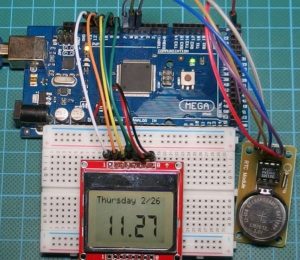Introduction
Hi guys, in one of our previous tutorials, we made a real time clock, using the DS3231 RTC Module and the 1602 LCD display module. For this tutorial, we will be building something similar using the DS1302 RTC module and the Nokia 5110 display module. Unlike the 1602 LCD module which was used in the previous tutorial, the Nokia 5110 LCD module has the ability of displaying customized graphics which will help us display our data with better UX.
At the core of this project is the DS1302 RTC module which is a trickle-charge timekeeping chip which contains a real-time clock/calendar and 31 bytes of static RAM. The real-time clock/calendar provides seconds, minutes, hours, day, date, month, and year information to the micro controller or processor to which its connected via a simple serial interface. The end of the month date is automatically adjusted for months with fewer than 31 days, including corrections for leap year. The device could be set to operate in either the 24-hour or 12-hour format with an AM/PM indicator.
Interfacing the DS1302 with a micro controller like the arduino is simplified by using synchronous serial communication. Only three wires are required to communicate with the clock/RAM: reset, data line, and CLK (serial clock). Data can be transferred to and from the clock/RAM 1 byte at a time or in a burst of up to 31 bytes. The DS1302 is designed to operate on very low power and retain data and clock information on less than 1µW.
The module is a successor to the DS1202 RTC module and asides the basic timekeeping functions of the DS1202, the DS1302 has the additional features of dual power pins for primary and backup power supplies, programmable trickle charger for VCC1. This capability makes it ideal for a long term real time clock project.
Read more: Arduino Real Time Clock with DS1302 and Nokia 5110 LCD Display

